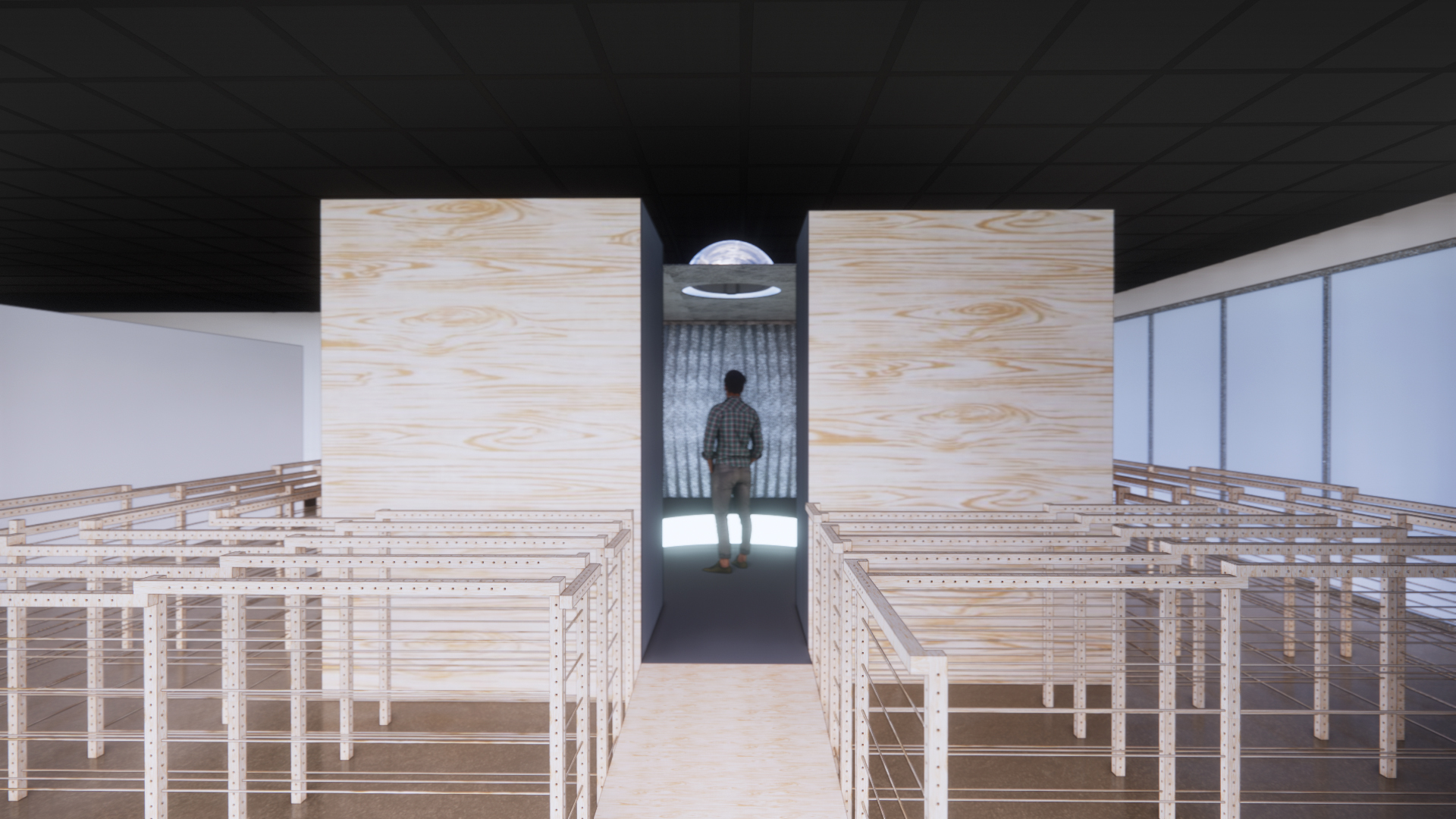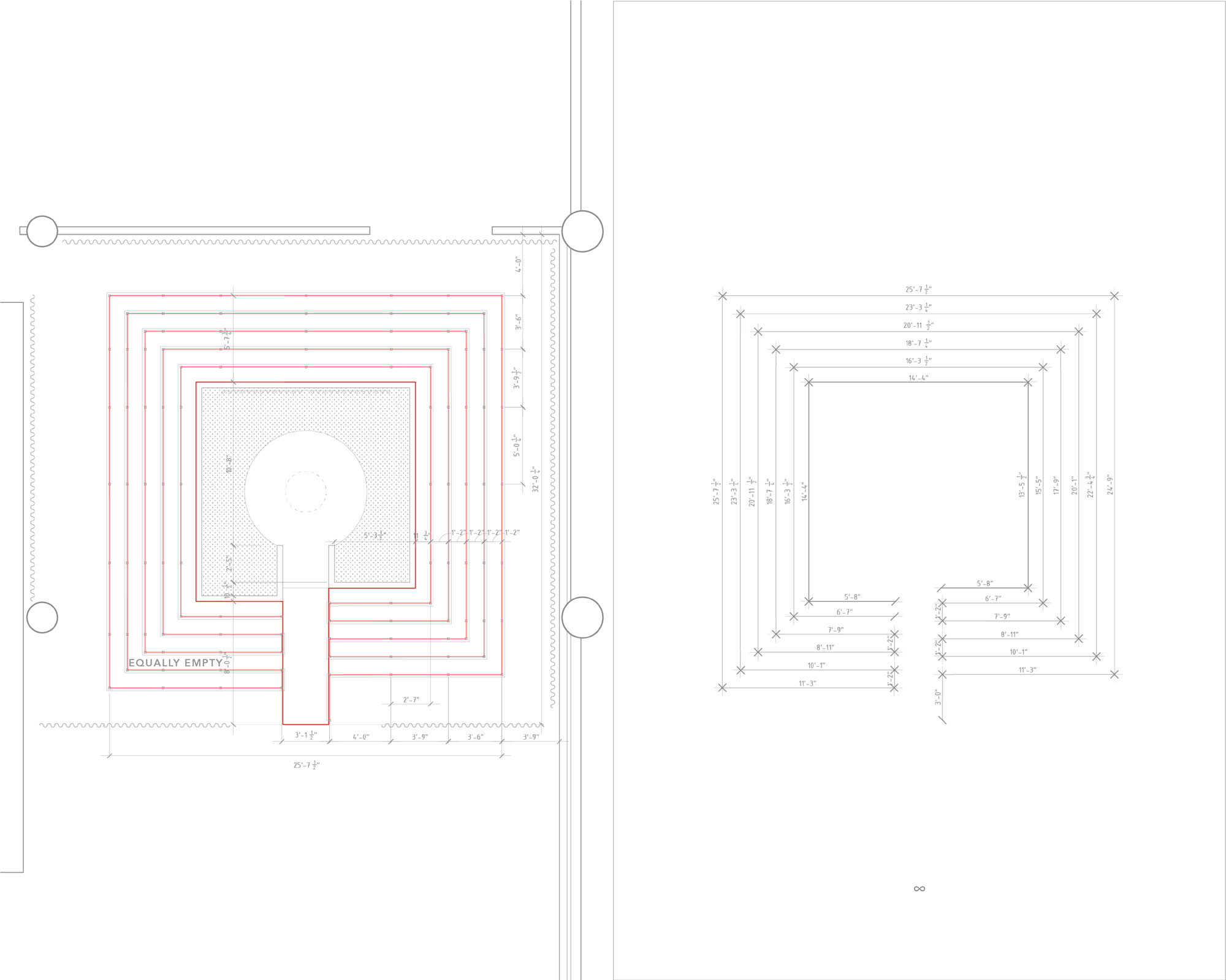Equally Empty
Nathan Byrne, Penny W. Stamps School of Art & Design
Collaborators: Sydney Farris, Master of Architecture, A. Alfred Taubman School of Architecture + Urban Planning, U-M (2020); Makenzie O’Connor, Master’s Degree in Design Science, U-M (2020); Endi Poskovic, Professor, Penny W. Stamps School of Art & Design, (Thesis Chair); Cynthia Pachikara, Professor, Penny W. Stamps School of Art & Design, (Advisor); Keith Mitnick, Associate Professor, A. Alfred Taubman School of Architecture + Urban Planning (External Advisor); Emmerich Anklam, Batchelor’s Degree in English Literature, Stanford University (2015), editor; Heyday Books, composer, musician, producer, writer; Dean Smith, artist, represented by Anglim/Trimble San Francisco, MFA in Painting UC Berkeley (1988)
This installation is titled Equally Empty, which will be an immersive and sensorial installation focused around an architectural structure, surrounded by a network of labyrinthine passages, this enclosure’s interior space will be activated by a soundscape and light play. The installation’s design generates from a small graphite drawing of a labyrinth by the artist Dean Smith.
I choose this particular drawing because I was already intrigued by the paradoxical labyrinth form and imagined this drawing as an opportunity for a transformative spatial encounter and I had an unexpected desire to build his drawing. By assigning this work the role of proposal drawing for my installation, I am utilizing his drawing as a plan while simultaneously transposing his drawing into space. The bodily-framed experience the viewer will have walking in or around the circuitous labyrinth and entering into an enigmatically altered environment will induce a kinesthetic and physical response to the surroundings. Once ensconced in the dimly lit enclosure, the mysterious congregation of short vertical columns surround the viewer who will stand within a keyhole-shaped absence in the floor created by the surrounding columns. The space is illuminated along the perimeter of the structure by a slowly pulsing light, enabling perception of the geometric panels on the back wall, while an ambient source of sound emits from above. The entire interior of the structure and all the vertical columns are painted Vantablack, which absorbs up to 99.965% of visible light, making the space cave-like. The space is charged by the phenomenal perceptions at play inducing a transformative experience in the viewer.
While the immersive structure and surrounding labyrinth are the heart of this project, there will also be an artist book titled Equally Empty, the artist Dean Smith’s graphite labyrinth drawing will also be on view in the exhibition. Sound, or absence of sound has played an integral role in much of my work, such as the dampened sound caused by the presence of three tons of shredded rubber in my prior installation work Elision, 2019. With Equally Empty, I will further investigate how a sonic element and light play can heighten the sensorial experience of an environment. As part of our on-going collaboration, the composer Emmerich Anklam will design and produce the sound for my MFA Thesis Exhibition Equally Empty. In addition to the nearly 20-minute-long ethereal soundscape which will emit from a parabolic speaker within the enclosure of the installation, Emmerich and I are also collaborating on a second track. For this second audio work I transcribed and arranged a text by the artist Gordon Matta-Clark to create an epic poem which explores language, emotion, and space. Emmerich is using a recording I made of my reading of this poem, and is creating a natural enclosure for the audio, it is as if the reading were taking place in a grove of trees, with wind blowing outside, and soft sounds of leaves and distant bells resonate in a landscape. The 2-track Equally Empty album will be available on cassette, and the album will also be offered as a free download with the artist book Equally Empty, which will be a takeaway object at the opening of the MFA Exhibition Heartened Surfaces which runs from March 12-May 2 at Stamps Gallery. An exhibition copy of this artist book will also be on display for the duration of the exhibition on a podium with an accompanying UV light for decoding the white ink on white paper.
For the print design of this artist book, I have been in collaboration with Makenzie O’Connor, who recently received a master’s degree in Design Science (2020) from the University of Michigan. Her efforts with the print design and typography have been crucial to this project, she also has been my lead consultant for the project as a whole. The Gordon Matta-Clark text which I fashioned into a poem titled Short Term Eternity, was garnered from his archive of index cards, and due to the artist’s learning differences is riddled with odd punctuation, grammatical aberrations, and erasures. Somehow, through our collective effort we were able to fashion the artist’s words into pure poetry while remaining true to the raw and unfettered nature of his prose. I was granted permission from the Gordon Matta-Clark Estate to use his text in both the Equally Empty artist book and album.
I’m also developing digital models of designs and building plans collaboratively with Sydney Farris, a recently graduated Master of Architecture from Taubman School of Architecture and Urban Planning (2020). We met while I was taking the Graduate Seminar Spatial Narratives in the Winter semester 2020. This course was a wellspring of interesting ideas about spatiality and led to the idea of making a thesis work which could explore embodied spatial perception, while also exploring language, and the relationship between space and drawing. It was in this course that I honed my skills in drawing in the language of architectural and incorporating text and language in my work. The collaboration with Sydney Farris has allowed us to render digital models and negotiate scale and form without having to build it first. This process has afforded me great freedom to modify the ideas in such a way that I can visualize it in order to make the needed changes to structural plans. Eventually I made a full-scale model of our plans, which will end up being the finished structure because it worked so well. Sydney also provided me with a detailed ‘cut list’ and instructions for preparing the building material. The digital models have also been a key factor as I present my research to my cohort and faculty during MFA critiques and thesis advisory meetings and in the fabrication of the project itself.
This project is a culmination of many aspects of my research and art practice, which considers sustainable design, and usage of materials. We hope to exhibit this project at other art spaces following the MFA Exhibition by disassembling and then re-deploying the ‘kit of parts’ at another site.


